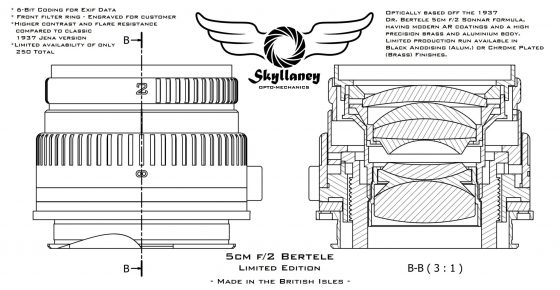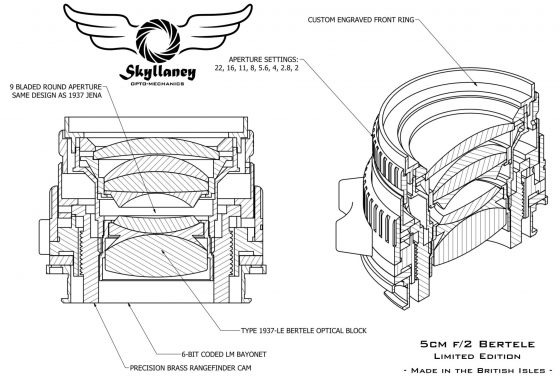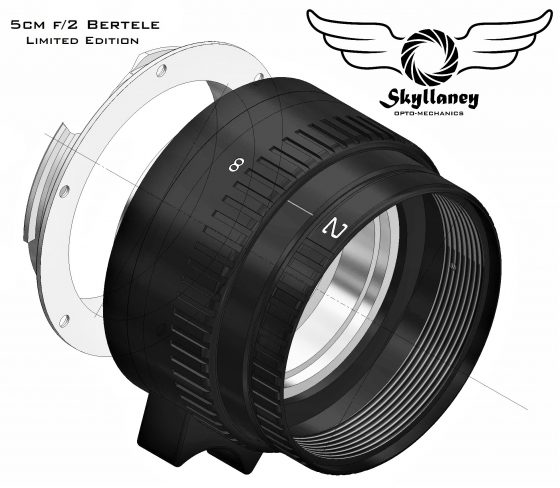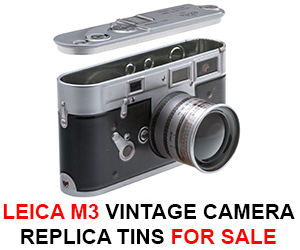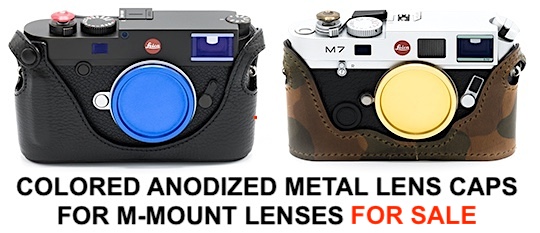
A reader sent me a link to this new lens manufacturer in England that is making rangefinder lenses: Skyllaney. The company just announced a new 50mm Sonnar lens for Leica M-mount called Bertele (Skyllaney 50mm f/2 Bertele):

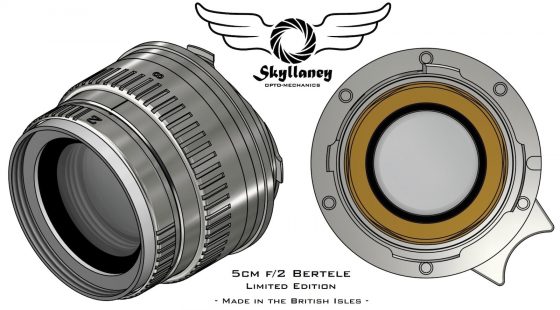
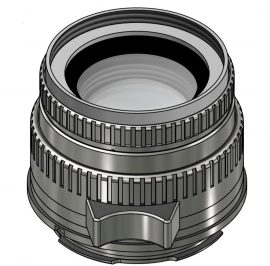
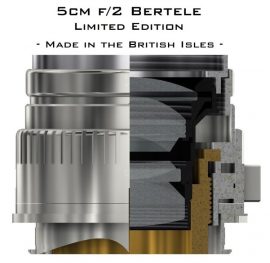
Here is the press release:
Introducing the Skyllaney: 50mm f/2 ‘Bertele’
By 2021 we hope to release our first limited edition run of a 50mm f/2 Sonnar formula lens, with native M bayonet, which optically is based very closely off the1937 pre-war era design by Dr Ludwig Bertele.
Our version contains the same element radii that were established by the good Doctor in 1937, but marries them with modern AR coatings which have increased contrast and reduced flaring. We also implement a 9 bladed 1937 sytle rounded aperture for enhanced bokeh, a high precision brass helicoid, 90-100 degree focus swing from 0.7m to infinity, a high-speed focusing body utilising a finger tab, all kept in a compact body no larger than the v4 cron. It will be initially offered in black anodised (6061 Aluminium) or chrome (Brass) finishes, with an initial run of 150 lenses, with possibly another 100 to follow. Each one will have the front filter ring customisable by the customer with up to 18 characters, in addiiton to ‘ Bertele 50mm f/2’ and each ones unique run serial number.
The optical blocks, lnes elements with modern AR coatings, and the 9-bladed 1937 aperture design are already at our workshop, all 170 initial sets. They are currently undergoing testing, and plan to be included in our ‘Big Sonnar Review’. At the moment, they are performing very close to the 1937 Jena originals, with the added benefit of higher contrast, punchier colours and greatly increased flare resistance, due to the AR coatings.
The high precision mechanical bodies are still a work in progress, as we want to be sure we get it right, not rushed. 20 of the inital 170 blocks we have we will use for pre-release prototype purposes, and some given to individual photographers to use in the field and provide us with feedback. After everyone involved is happy, we will then finalise the design and begin the production manufacturing runs.
Many parts of the lens, final assembly, engraving, testing, calibration and collimation is all performed here in England, with each final specimen being checked then by our chief Opto-Mechanical Engineer. Pending the success of our first lens, we look to do a limited run of at least one new lens design each year going forward.
There are already discussions of what that next lens will be. At the moment, we plan on either doing an ultra-compact 28mm or a 85mm f/1.4 portrait lens next, which would be native M mount also. The portrait lens would be early Planar formula based (simliar to the Contax version), while we are interested to see if a 28mm Sonnar derivative lens could be designed sucessfully. We know Mizakisan struggled with this, and maybe we will also have to abandon this hope, but we shall have to wait and see. Ideally, our ultra-compact 28mm would be between f/2 to f/2.8 aperture, no larger then a M mount bayonet cap when mounted on the cameras, and ofcourse include a finger tab for quick focusing.
Lastly, we are exploring what we call the ‘Super Sonnar’ project. It would be a 50mm f/1 Sonnar formula lens, that would include an FLE in a certain strategic location to eliminate the Sonnar focus shift. Two of us on our team made some early discoveries about Planoconvex lenses being used on rangefinder wide-angle to eliminate aberrations and field curvature on thick filter glassed digial sensors. A few years ago, a photographer in Japan named HaruhikoT discovered that placing optical laser correction filters on Contax G lenses, the field curvature and incorrect dispersion of light in the corners, which was causing corner smearing, could be almost entirely eliminated with the addiiton of a front correction lens. When we read this, we procured plano-convex lenses ourselves made by OptoSigma, Ekspla and Zeiss, and began to place them on the near full sets of Zeiss ZM and Voigtlander VM lenses we had in our personal collections. The Plano-Convex and Proxar lenses (also known as close up filters) were found to work exceptionally well, once the key correction strength needed, was optimally determined.
From early experiments with correction lenses, we had learned that adding an element to existing optical formulas in strategic locations could make previously unusable lenses that had compatibility issues with the thicker front filter glasses on Sony, Fuji, Canon type digital cameras, perform much better.
We began to explore if a floating correction lens elemnt could be used to cure the Sonnar focus shift, without negatively affecting its rendering.
The Super Sonnar lens would have its central 25% of the image frame sharp wide open, but leave the natural aberrations present in the formula remain in the other in the outer 75%, so that the spehrical abberation is pruposely not corrected, to ensure the sanctity of the bokeh remains.
We have been careful to design and implement the FLE not to remove the character of the Sonnar formula, but enable the shift from that formula to be taken merely under our control.
Without an FLE, a Super Sonnar lens, calibrated to focus accurately at say f/1 wide open across the range, would shift too much due to its spherical aberration reduction in the outer edges of the elements as the lens would stop down, aperture wise. That shift would be massive, possibly having the lens go soft by f/2.8 and not return sharp until DOF catches up at f/8. This is not too big of an issue on cameras that have through sensor image feeds (live view and EVF), where aperture specific re-focusing can take place. However, the rangefinder has no way of compensating for focus shift between apertures. So, if we want f/1, and we want it usable by rangefinder users across its aperture, and sharp enough so at MFD, wide open, it still got some pop and pizazz, we have to go down the FLE route.
We already have early designs for this Super Sonnar lens and are trying to keep the computations as close to some optical diagrams we studied that Dr Ludwig Bertele created in the late 1930’s onward. Mostly, we are trying to extrapolate out these old formulas, to create an f/1 lens that is merely a two stops faster version of the original collapsible 5cm f/2 Jena. All the while, we are trying to ensure it does not become too big also in that process, and incorporate an FLE to manage the formuals focus shift. A design constraint of no heavier then 475g has been set, but already the front element has been calculated to be between 58-61mm in diameter if we want an actual f/1 lens. We may have to use mostly lightweight aircraft aluminium, similar to the MS Optics ISM 50mm f/1.0.
Two of us on the team have this MS Optics lens already, and we are amazed how small they have gotten it, though we can see also by using the rotating element design with sloped CAM, they were able to save on things like fork sliders, thus reducing space.
Our design is planned to be a non-rotating front, no different as to how f/1Noctilux works.
Limited run boutique lenses became an idea from seeing other companies, such as MS-Optics, do well in this area. If anything, we are more inspired by Mizakisan than anything else and would like to see others enter into this market . All of us have great respect for Mizakisans’s work, and it is why we believe we could also begin to design lenses in small batches that were made to high-quality standards, and succeed at this.
If you would like to receive updates on the ‘Bertele’ lens project, including the pre-order and release dates, please enter your details in the form below and we’ll add you to our ‘Bertele’ exclusive email list.
Get 15% off on all Topaz Labs products with code RUMORS15 Get $10 off Skylum Luminar 4.2 with code LEICARUMORS Get 15% off on all DxO software with code GETDXO15NOW Get 40% off Rocky Nook books with code NIKONRUMORS Get 10% off Exposure X5 software with promo code NIKONRUMORS
